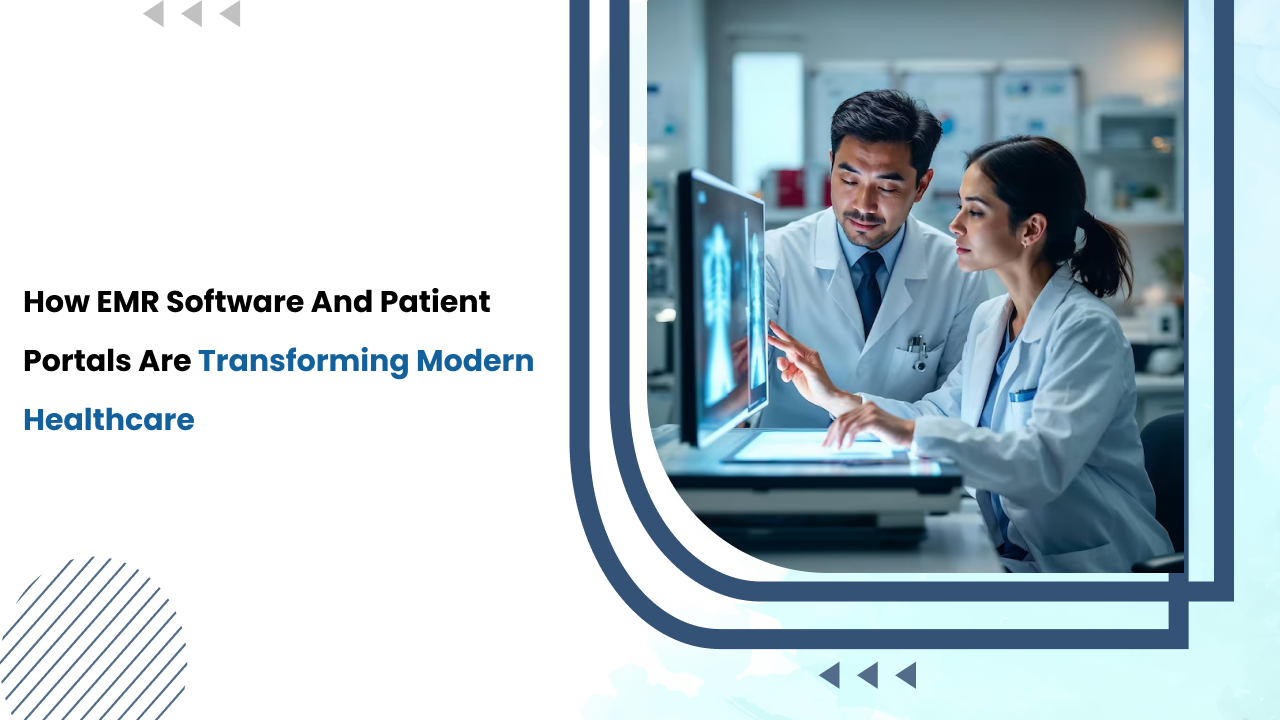
Quick summary
Moving to the digitization of records, EMR Software and Exchange empower patients real-time access to their health data, while increasing the efficiency level. These integrated systems further improve workflow, accuracy, and secure communication between doctors and patients. Cloud-based mobile AI-powered EMR software solutions are being rapidly adopted by healthcare providers in India to enhance the quality of care, patient involvement, and security of data in clinics, hospitals, and telemedicine platforms.
Introduction
The winds of change in health care evolution and communication have growndemanding more efficient and patient-friendly modes of health care. Among potential developments introduced by currents of storm, the most probably talked-about would be software applications developed for Electronic Medical Records, signifying the e-digitization of paper medical records into databases that permit authorized personnel to read, manage and store them in a secure manner to access them anywhere. Most of the time, these software applications are complimented with functionalities of patient portals that facilitate better communication between patients and healthcare providers through electronic means. All these elements are contributive to greater openness and optimization in personalized health care settings.
In India, EMR Software has been breaking grounds into the limelight slowly as the value it adds in addressing issues such as data management, the patient in engagement and care coordinated with hospitals, clinics, and diagnostic centers.
Overview of EMR Software
Electronic healthcare provider systems which are associated in some way with EMR software systems feature a lot of communication to save and control patient data in a secured structured environment. Some are nourishing areas that may be included in the transmission of patient information: clinical notes, lab results, medical histories, prescriptions, or treatment plans, etc. These are indeed all the things that allow the calling up of documents in one: no duplication, no errors, and most efficient in comparison with paper records.
This EMRs Software Solution will actually be the last brush of streamlining the workflow of doctors and health institutions. Patient visit, e-prescription, billing, lab results available from one dashboard. Compliance with the above standards-HIPAA, HL7, ICD-10 shall put a seal of confidentiality and interoperability on the data.
Different Modules Access in EMR Software
Current EMR Software Solutions are modular and various modules coexist under one roof relating to varied operations, such as those from a healthcare setup. Some of the most significant EMR modules would be:
Patient Registration & Demographics
This will be the module which would gather information about the patient required to get- name, address, age, sex, contact details, and insurance information. Thus, it will ensure full electronic record from day one and avoid any possible errors caused by manually entering that data.
Appointment scheduling
The intelligent scheduling module allows organizing appointments by staff and patients. This is integrated into the patient portals through which patients can make online bookings, reminders, and rescheduling thereby contributing to decreased no-shows by patients as well as administrative burden.
Clinical Documentation
In-system doctor uses templates or voice dictation tools for consultations, diagnoses, and treatment plans. In this way, the patient's record gets updated automatically into the system for future reference.
E-Prescription
This allows the doctor to create an e-prescription or processed electronic prescription. It has a very positive effect to reduce the illegible prescription errors. E-prescribing enhances patient safety by checking for possibly drug interactions and allergenic conditions to patients.
Laboratory and diagnostic integration
This module has every part of work applied in all their laboratories that would apply the results within the patient portal. Clinician decision making becomes far more independent with improved information processing.
Billing and Revenue Cycle Management
This module completely presents automation being offered in a consultant to procedure module where all charges are attached to one single entity, including the technician insurance claims, coding, and payment tracking.
Reporting and Analytics
Analytics shall provide insights through which administrators will be measuring performance against.
Security and Compliance
The modern EMR Software solution raises concerned issues concerning data privacy; it has role-based access, encryption, and audit trails that will protect sensitive knowledge.
Patient Portals: Role in Today's Modern Health Care
The EMR Software administers clinical operation procedures within the health institution internally while on the other hand, the patient portals function as the external face of health providers to the patients. In other words, patient portals are private online setups for patients that provide patients with the capability of viewing personal records, scheduling appointments, checking lab results, paying bills, and messaging their doctors.
Patient portal features of EMR Software cover many of the clinical operations that were previously conducted traditionally in a hospital between a patient and caregivers. A patient logs in to review the medical history and downloads the prescription instead of visiting a hospital repeatedly for asking simple questions or sitting on reports before responding.
Ultimately, they can not only improve the visibility of health providers but also achieve significant incremental savings regarding administrative overhead costs while strengthening their relationships with patients. Further, this opens new doors for EMR Software in India with multilingual patient portals at making public access urban or rural because it varies throughout India in terms of health access and literacy.
Advantages of EMR Software and Patient Portal Integration
Enhanced Care and Safety for Patients
Essentially, access to accurate and current information enhances treatment decisions. The use of EMR Software lessens the risks associated with lost or misfiled paper documents and reduces the risk of medication errors through e-prescribing and alert systems.
Efficiency Increases Workload Reduction
The providers now have more time to allocate towards their patients and much less time on paperwork. With integrated patient portals, contacts are reduced greatly further from phone calls and the need for manual follow-ups.
Busy Patients Benefit More
More empowered patients take more interest in taking care of themselves. Pulling their records online as well as test results and educational materials greatly enhances their ability to better monitor progress and share in care planning.
Financial Transparency and Faster Payment
Patient portals ease collection of payments from patients and submission of claims to insurance companies. Smoother and more transparent billing is achieved with electronic receipts, online payment options, and automated reminders.
Data Analytics and Population Health Management
With the adoption of the latest features in EMR Software Solutions, users can now be part of advanced analytics that involves trend analyses and tracking outcomes as a prelude to intervention. This is especially useful for public health agencies as well as large hospital networks across India that attract massive patient numbers.
Transforming Indian EMR Software
Indeed, the adoption of EMR Software in India has gained of late momentum born out of the governmental push for the development of a digital health infrastructure under the Ayushman Bharat Digital Mission(ABDM). Hospitals and clinics implement EMR Software to strengthen their operational efficiency and data-sharing abilities and comply with the national standards of health care interoperability.
Localized Features and Customization
The Indian health care system is quite different from those in the West; it has everything in a very diverse form, with big multispecialist hospitals on the one hand and small private clinics on the other. Therefore, EMR Software Solutions gradually developing in India are being made to suit local needs by way of multilingual interfaces, local coding standards, and interoperability with telemedicine platforms.
Solutions Mobile First and Cloud Based
With the quick advent of cloud computing alongside smartphones, making EMR Software accessible to small and medium categories of healthcare providers is made possible. They do not require much infrastructure and can be accessed with the highest safety assurance anywhere in the world, including in rural health centers and mobile clinics.
Integration with Telehealth
Tele-earliest consultations now fall form one of the pillars particularly for healthcare delivery in the post-COVID world. By embedding the functions of telemedicine in EMR Software, doctors can check a patient's record, prescribe a medicine, as well as share the patient's digital prescriptions, all in real-time.
Compliance and Security
Indian healthcare providers have begun improving their attention toward data security laws with the introduction of the Digital Personal Data Protection Act (DPDP). Thus, the modern Electronic Medical Records Software comes equipped with a wide variety of encryption and role-based authentication to secure a patient's data.
Some Challenges of Integrating EMR Software
Although EMR software has a number of promises of benefits, these present challenges are the reasons for not using EMR widely, especially in developing areas.
High Initial Costs of Implementation
Most health institutions, particularly small ones, would find it unbearable, if not impossible, to afford a full EMR system. However, cost barriers are being chipped away by the entry of cloud solutions and subscription models.
Resistance to Change
The very thought of going digital is an anathema to many doctors who restrict themselves to old-fashioned paper-based systems. With adequate training and simple user-friendly interfaces, most of these systems would gain popularity.
Lack of Compatibility in Information Processing Between Systems
The source hospitals and the systems essentially speak in different alien-like data formats, which renders transfer absolutely complex. This has been contributed toward with the growth of standardized protocols like FHIR and HL7, among others.
Issues of Data Integrity
Security and integrity of patients could then be tightly locked as threats grow in cyber security. Regular audits and compliance frameworks might mitigate such problems.
Future Forecasts about EMR Software along with Patient Portals
Next-generation EMR Software Solutions will now talk to AI and ML as a bonus, which makes these solutions more powerful through data analytics generating predictive healthcare insights. Such a system would be able to forecast the early signs of chronic diseases and recommend the best treatment pointers, and would be able to maintain its own documentation through voice recognition.
With the seamless connection of these sensors and wearables to the EMR Software, it would allow patients to monitor their vital signs in real-time from a distance, far from the health institution. Beyond that, the future promises to advance health data security and interoperability unrecognizably beyond anything currently possible with blockchain technology.
Under the furious investment by the Indian government into the digital health infrastructure, this is thus far coupled with another set of initiatives coming from the private sector. All these would ensure that in India, EMR Software stands a chance of playing a worthy role in universal, efficient, and patient-centered health care.
Conclusion
All this dimension has completely changed health care delivery with the coming of Electronic Medical Record Software and patient portals into existence. It has increased efficiency, created a two-way communication platform, and most importantly, empowered the patients to take charge of their own health.
It is expected that patterns of adoption will rise in connection with EMR Software in India, and workers in the health care sector stand to benefit from enhanced workflows, secure data management, and increased patient satisfaction. There are great changes happening in health delivery with the digital quality-care delivery system getting into full gear, and having EMR Software Solution is now mandatory even for small clinics.
